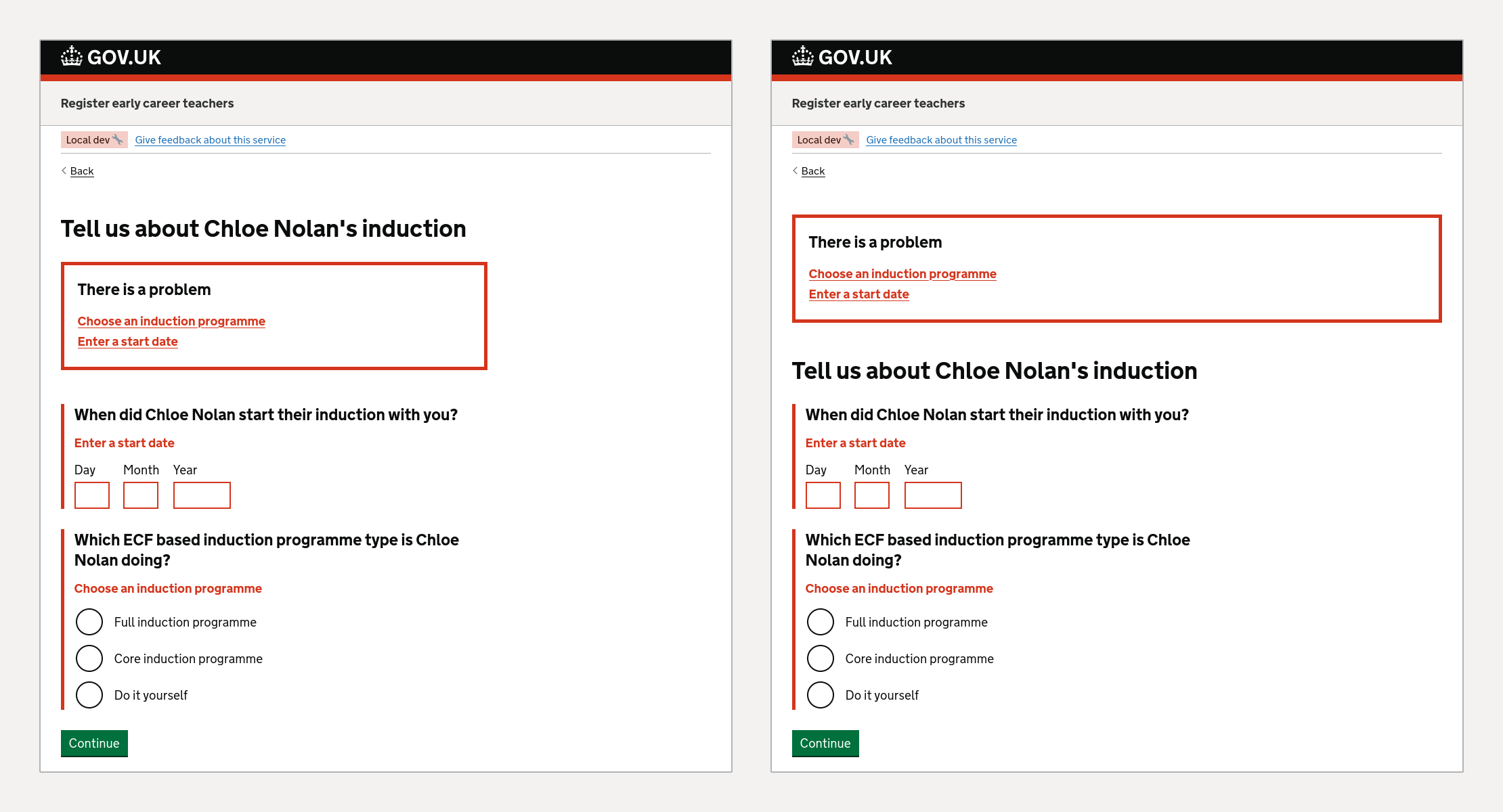Finishing touches for forms

The GOV.UK formbuilder makes it easy for Ruby on Rails developers to build forms that follow the rules set out in the GOV.UK Design System.
It generates the correct HTML, provides a nice API for customising the fields to meet the needs of your service and takes care of clearly displaying any error messages.
There are, however, some suggestions in the Design System guidance that go beyond the remit of the form builder.
They are often forgotten, we’ll go over some simple ways to solve them here.
Positioning the error summary at the top of the page
In addition to making it clear that something is wrong, we also need to tell the user exactly what happened and how to fix it.
Put the error summary at the top of the main container. If your page includes breadcrumbs or a back link, place it below these, but above the
<h1>.
This is problematic because the form often isn’t the first thing on the page but the form builder needs to be responsible for rendering the error summary to ensure the links and targets are consistent.
We could solve the problem by wrapping the whole page in a <form> element, which would allow us to place the error summary wherever we like, but it’s a hack. It isn’t semantically correct and is likely to lead to other problems.
Thankfully, Rails has our backs. We can use content_for to insert content into a named block in our layout. If we add a named block called top_of_main at the top of our <main> element, like this:
<div class="govuk-width-container">
<main class="govuk-main-wrapper" id="main-content">
<%= yield :top_of_main %>
<h1 class="govuk-heading-xl">Default page template</h1>
<!-- the rest of our page -->
We can send our error summary from the form to it, like this:
<%= form_with(model: @object, url: some_path) do |form| %>
<%= content_for(:top_of_main) { form.govuk_error_summary } %>
<%= form.govuk_text_field(:how_many_juggling_items) %>
<% end %>
And now our error summary is in the right spot.

Prefixing the page title with ‘Error:’
When a form submission results in a validation failure we need to make it clear to the user that something is wrong.
Add ‘Error: ’ to the beginning of the page
<title>so screen readers read it out as soon as possible
This is a little tricky because we need some logic that can determine whether there’s an error on the page, and we set the <title> in the document <head> before we’ve rendered the form in the <body>.
We can use content_for here too to place the title where we need it.
<head>
<%= tag.title(yield(:page_title)) %>
<!-- other head content -->
</head>
We can use the GOV.UK Components title with error prefix helper to add the ‘Error:’ prefix whenever @object.errors.any? is true, and pass the resulting string into the page_title content:
<%
content_for(:page_title) do
title_with_error_prefix(
"How many implements can you juggle with?",
error: @object.errors.any?
)
end
%>
Making sure error links to checkboxes and radios work
The form builder comes with two ways to build lists of checkboxes and radio buttons.
The simplest is to use #govuk_collection_check_boxes and #govuk_collection_radio_buttons, which mimic the behaviour of their Rails counterparts.
You just pass in the list of options and the form builder will render them. This works for simple lists.
Sometimes, however, the list needs to be customised a little further. For example we might need a conditionally revealed questions or a divider.
To support this the form builder comes with the more powerful #govuk_check_boxes_fieldset and #govuk_radio_buttons_fieldset methods which let the developer build the form field by field.
This power comes at a cost. For example you could write something like this. Here, delete will only be shown to admins:
f.govuk_radio_buttons_fieldset(:close_ticket)) do
if @user.admin?
f.govuk_radio_button(
:close_ticket,
'delete'
)
end
f.govuk_radio_button(
:close_ticket,
'archive'
)
# the rest of the options
end
This would make it impossible for the error summary to accurately link to the first checkbox or radio button without repeating the logic — an approach that’s going to lead to bugs when it’s updated in one place but not the other.
Instead, we have to help the error summary by ‘marking’ the field we want the error summary to link to with link_errors: true. This overrides the ID generation so the link in the error summary will match it.
f.govuk_radio_buttons_fieldset(:close_ticket)) do
if @user.admin?
f.govuk_radio_button(
:close_ticket,
'delete',
link_errors: true
)
end
f.govuk_radio_button(
:close_ticket,
'archive',
link_errors: @user.regular_user?
)
# the rest of the options
end
Now when there’s a validation error, regardless of whether the user is an admin or not the error summary will link to the first option. It’s a good idea to write some tests to ensure future changes don’t affect it.
These finishing touches will help make sure your forms are usable and accessible.
If you have any feedback or suggestions of other form features commonly missed, let us know.